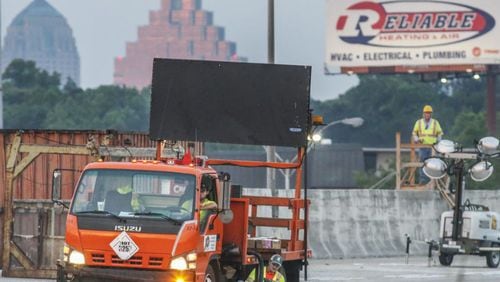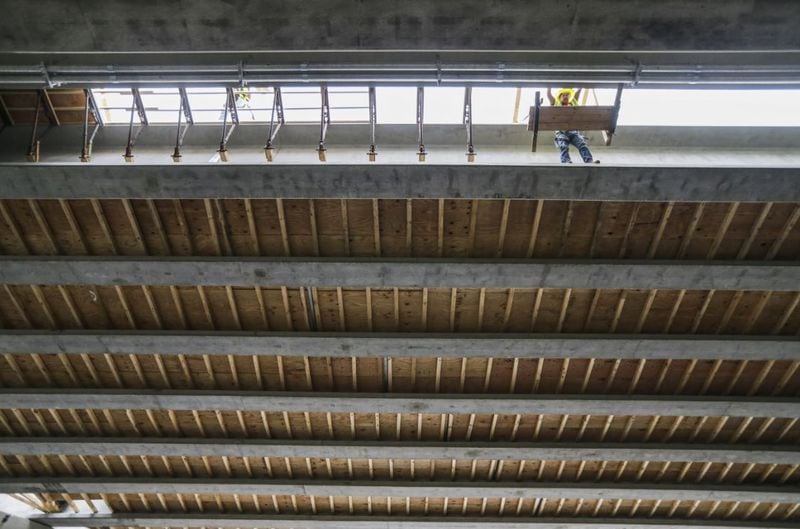Six weeks ago, an elevated highway that carried hundreds of thousands of people a day lay in smoking ruins, and metro Atlanta residents despaired at what surely would be months of punishing commutes.
This weekend, the state opened all lanes on the rebuilt section of I-85 - a full month ahead of schedule - leaving commuters to marvel at what looked like an engineering and construction miracle.
Cars began traveling the northbound lanes again Friday night. The southbound lanes followed, reopening Saturday night.
But experts say it’s no miracle. In fact, “accelerated bridge construction” isn’t even unusual. What’s more, it’s perfectly safe and should be used more often, they say.
“Once the public sees it, they will demand it,” said Atorod Azizinamini, chairman of the civil and environmental engineering department at Florida International University. “`Why don’t they do that with every bridge?’”
The Georgia Department of Transportation has used accelerated construction techniques before and likely will again. But the I-85 project is by far the largest such project it has undertaken.
The highway went up in flames and collapsed near Piedmont Road on March 30. A homeless man, Basil Eleby, has been charged with setting the blaze, which then spread to construction material GDOT stored beneath the highway.
Georgia’s quick response began before the blaze was even extinguished. That night, engineers began reviewing plans for the original bridge. Within a few days, they completed design of the new one.
The state enlisted contractor C.W. Matthews, which began working without a contract. But the eventual deal they signed played a big role in the pace of construction: The contractor stands to earn $3.1 million in incentives for finishing a month before the original June 15 completion date.
MORE: Bridge for I-85 bridge repair still rising
RELATED: After I-85 fiasco, is MARTA ready for its close up?
GDOT Construction Director Marc Mastronardi told the House Transportation Committee this week those incentives inspired the 24 hour, seven-day work schedule C.W. Matthews has maintained since the work began.
Good weather and quick-curing concrete also sped construction. So did good luck – the original bridge’s foundation was not damaged in the fire, and workers were able to shore up the 13 existing columns.
Mastronardi told The Atlanta Journal-Constitution that extra manpower allowed C.W. Matthews to do a variety of work simultaneously – a key to accelerated construction.
The fast pace comes at a price. The I-85 construction project will cost up to $16.6 million, most of that federal money. Mastronardi said it's difficult to tell how much it would have cost under a normal construction timetable. But one indication: The quick-curing concrete costs about twice as much as the typical concrete used in road construction.
But construction cost wasn’t the only factor. State officials say getting the bridge done early will have a positive economic impact of $27 million, including the cost of workers’ time while they were stuck in traffic.
Azizinamini said that kind of broader savings is one reason accelerated bridge construction has become more common over the last decade. In 2011, Massachusetts replaced 14 bridges over 10 weekends. In fact, he said it’s hard to find a state that hasn’t used such techniques.
Georgia, too, has used accelerated construction techniques. One example: the Ga. 299 bridge over I-24 in Dade County in North Georgia. After building the new bridge nearby, the state will demolish the old bridge and set the new one in place this weekend, minimizing traffic disruption.
Because its collapse disrupted the lives of hundreds of thousands of commuters, the quick I-85 reconstruction has gained far more attention – and some questions about whether the bridge is safe.
Mastronardi said GDOT has had inspectors at the site 24 hours a day. They have monitored the construction and tested the concrete used to build the new bridge. They even inspected and approved each of the 61 concrete beams as they were manufactured.
Mastronardi said the speed of I-85 construction is “not a matter of anybody doing something inferior or cutting a corner.”
Azizinamini said accelerated bridge construction is safe. And he thinks it should be used more often.
“It should be done fast,” he said. “Disruption to the traffic should not be there. We have the technology that we can replace a bridge in a matter of hours or a weekend.”
About the Author








